Chronic Bronchitis
Medically reviewed by Drugs.com. Last updated on Aug 4, 2025.
Chronic bronchitis is a long-term swelling and irritation of the airways in your lungs. The irritation may damage your lungs. The lung damage often gets worse over time, and is usually permanent. Chronic bronchitis is part of a group of lung diseases called chronic obstructive pulmonary disease (COPD).
 |
DISCHARGE INSTRUCTIONS:
Call your local emergency number (911 in the US) if:
- You have new or worsening chest pain or tightness.
- You become confused, dizzy, or feel like you may faint.
Seek care immediately if:
- You have a new or increased gray or blue tint to your nail beds, fingers, or lips.
- You cough up blood.
- You have new or increased swelling in your legs, ankles, or abdomen.
- The amount or color of your sputum changes, or your sputum becomes too hard to cough up.
Call your doctor or pulmonologist if:
- You have a fever.
- You use your inhalers more often than usual.
- You run out of breath easily when you talk or do your usual exercise or activities.
- You have questions or concerns about your condition or care.
Medicines:
You may need any of the following:
- Bronchodilators help open your airways so you can breathe easier. You may be given your medicine in a mist form so that you can breathe it into your lungs. Your medicine may be delivered through an inhaler or through a mask attached to oxygen. Ask your healthcare provider to show you how to use your inhaler correctly.
- Steroids help decrease inflammation in your airway so that you can breathe easier.
- Antibiotics treat a bacterial infection.
- Take your medicine as directed. Contact your healthcare provider if you think your medicine is not helping or if you have side effects. Tell your provider if you are allergic to any medicine. Keep a list of the medicines, vitamins, and herbs you take. Include the amounts, and when and why you take them. Bring the list or the pill bottles to follow-up visits. Carry your medicine list with you in case of an emergency.
Related medications
Treatment options
The following list of medications are related to or used in the treatment of this condition.
You may need to use extra oxygen at home
if your blood oxygen level is lower than it should be. You will be instructed on how to use oxygen in your home.
How to use an inhaler:
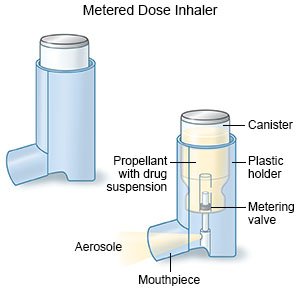 |
- Shake the inhaler well to make sure you get the correct amount of medicine per puff. Remove the cover from your inhaler's mouthpiece. If you use a spacer, connect your inhaler to the flat end of the spacer.
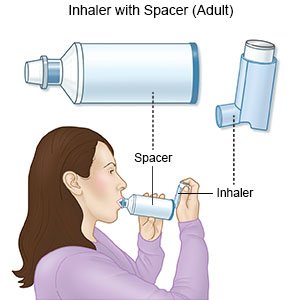
- Breathe out as much air from your lungs as you can. Put the mouthpiece in your mouth past your front teeth and rest it on the top of your tongue. Do not block the mouthpiece opening with your tongue.
- Breathe in through your mouth at a slow and steady rate. As you do this, press the inhaler to release the puff of medicine. Finish breathing in slowly and deeply as you inhale the medicine. When your lungs are full, hold your breath for 10 seconds. Then breathe out slowly through puckered lips or through your nose.
- If you need to take more puffs, wait at least 1 minute between puffs.
- Rinse your mouth with water after you use the inhaler. This may prevent a mouth infection or irritation.
- Follow the instructions that come with your inhaler to clean it. You should clean your inhaler at least 1 time each week.
Ways to help you breathe better:
- Take deep breaths and cough 10 times each hour. This will decrease your risk for a lung infection. Take a deep breath and hold it for as long as you can. Let the air out and then cough strongly. Deep breaths help open your airway. You may be given an incentive spirometer to help you take deep breaths. Put the plastic piece in your mouth and take a slow, deep breath. Then let the air out and cough. Repeat these steps 10 times every hour.
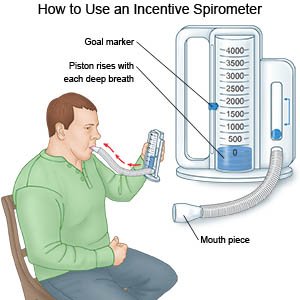
- Pursed-lip breathing can be used any time you feel short of breath. Pursed-lip breathing can be especially helpful before you start an activity:
- Breathe in through your nose. Use the muscles in your abdomen to help fill your lungs with air.
- Slowly breathe out through your mouth with your lips slightly puckered. You should make a quiet hissing sound as you breathe out.
- Try to take twice as long to breathe out as it did to breathe in. This helps you get rid of as much air from your lungs as possible.
- Repeat this exercise several times. When you are used to doing pursed-lip breathing, you can do it any time you need more air.
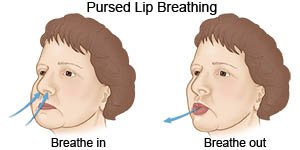
- Diaphragmatic breathing can help strengthen some of the muscles you use to breathe:
- Place one hand on your stomach just below your ribs. Place your other hand in the middle of your chest over your breastbone.
- Breathe in slowly through your nose, as deeply as you can.
- Breathe out slowly through pursed lips. As you breathe out, tighten the muscles in your stomach. Use your hand to gently push in and up while tightening the muscles.
- Diaphragmatic breathing takes practice. You may need to practice this many times a day. Slowly increase the amount of time you spend during each practice session.
Manage chronic bronchitis:
- Check your oxygen level, if directed. Your healthcare provider may recommend you use a pulse oximeter (pulse ox). A pulse ox is a device that measures the percentage of oxygen in your blood. You may be given a percentage target for when you are at rest and another target for activity. Your provider may want you to keep a record of your oxygen levels. Bring the record to follow-up visits as directed.
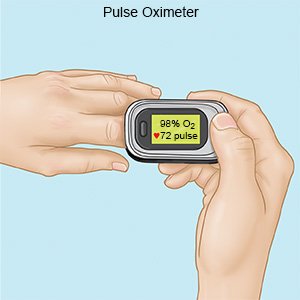
- Sleep with your upper body raised. This will help you breathe easier. You can use foam wedges or elevate the head of your bed. Many devices are available to help raise your upper body while in bed. Use a device that will tilt your whole body, or bend your body at the waist. The device should not bend your body at the upper back or neck.
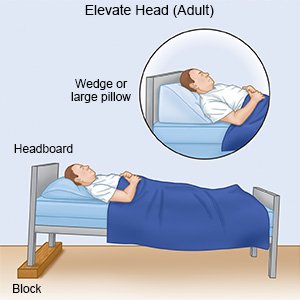
- Prevent the spread of germs:
- Wash your hands often with soap and water. Carry germ-killing gel with you. You can use the gel to clean your hands when soap and water are not available.

- Do not touch your eyes, nose, or mouth unless you have washed your hands first.
- Always cover your mouth when you cough. Cough into a tissue or your shirtsleeve so you do not spread germs from your hands.
- Try to avoid people who have a cold or the flu. If you are sick, stay away from others as much as possible.
- Ask about vaccines. Get a flu vaccine every year as soon as recommended, usually in September or October. Get recommended COVID-19 vaccine doses and boosters. Ask about other vaccines you may need, and when to get them.
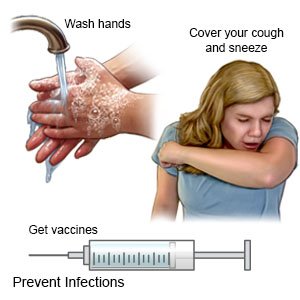
- Wash your hands often with soap and water. Carry germ-killing gel with you. You can use the gel to clean your hands when soap and water are not available.
- Do not smoke. Nicotine and other substances can cause lung damage. Do not use e-cigarettes or smokeless tobacco without first talking to your healthcare provider. They still contain nicotine. Ask your healthcare provider for information if you currently smoke and need help to quit.
- Avoid lung irritants. Stay out of high altitudes and places with high humidity. Stay inside, or cover your mouth and nose with a scarf when you are outside during cold weather. Stay inside on days when air pollution or pollen counts are high. Do not use aerosol sprays such as deodorant, bug spray, and hair spray.
- Go to pulmonary rehabilitation (rehab), as directed. Pulmonary rehab is a program to help you improve your lung function. You will learn exercises to help clear mucus from your airways and strengthen your lungs.
- Drink more liquids. This will help to keep your air passages moist and help you cough up mucus. Ask how much liquid to drink each day and which liquids are best for you.
Follow up with your doctor or pulmonologist as directed:
Write down your questions so you can remember to ask them during your visits.
© Copyright Merative 2025 Information is for End User's use only and may not be sold, redistributed or otherwise used for commercial purposes.
The above information is an educational aid only. It is not intended as medical advice for individual conditions or treatments. Talk to your doctor, nurse or pharmacist before following any medical regimen to see if it is safe and effective for you.
Learn more about Chronic Bronchitis
Treatment options
Care guides
- Acute Bronchitis
- Acute Bronchitis in Children
- COPD (Chronic Obstructive Pulmonary Disease)
- Chronic Bronchitis
Symptoms and treatments
Medicine.com guides (external)
Further information
Always consult your healthcare provider to ensure the information displayed on this page applies to your personal circumstances.
